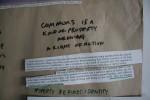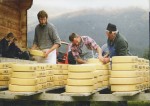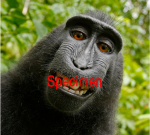When we talk about commoning in the arts, or of artistic production as a site of commoning, or the arts as a common good, we evoke economies of material and immaterial labour within the field of art. But we seldom consider the changing understanding of what an artist is, and how this historic subjectivity possibly undergoes a dramatic shift in response to the resurgence of the commons debate in the last few years. Not only do we need to ask ourselves how to be an artist and a commoner today, and how to produce art within commoning processes, but also what kind of a new artist subjectivity is summoned by the commons. Long gone is the conception of the artist as a craftswoman, long gone the conception of a solitary genius, yet the market still welcomes the individualistic producer, enamoured with the beautified reflection the neo-liberal consumer finds in the persona of the free-to-do-anything, singular novum-art-maker. At the same time the contemporary art market (at least its attention, if not its monetary economy) has embraced commoning as a method for artistic production and encourages the artist to engage with the surrounding world. But is it really the same type of artist that emerges in the (economic) contexts traversed by the artist commoner? She travels from commoning to capitalism, to gift economy, and back. How are those subjectivities negotiated with the citizen of capitalism who she inadvertently also is?
Does commoning, as a means of artistic practice, require a radically different self-conception of the artist? And if we see the emergence of a different artist subjectivity, what role does (self-)education in the arts play in fostering and welcoming this subjectivity? What kind of (educational) institutions can the artist-commoner take root in? How can these institutions engage not only in educating the artist about the commons but in developing radical methodologies of commoning education?
During a two day event, a.pass welcomes a gathering of researchers, artists, a.pass program participants and public to engage with the struggle of being an artist commoner today, and the role of (educational) institutions in bringing this subject about.
Two days of presentations, exchanges and commoning practices. Two days of ateliers, books launches, performances, workshops and discussions.
free admission - except the performance of Juan Dominguez - tickets
PROGRAM
Friday November 25
10:00-16:00: Open space / habitat, with: a.pass participants. (@dance studio)
11:00-15:30: office-work,
with Femke Snelting, Kate Rich, Magda Tyzlik-Carver.(@concert studio)
15:30-17.30: Regime Change, presentation after office-work,
with: Femke Snelting, Kate Rich, Magda Tyzlik-Carver. (@concert studio)
18:00-23:00: Common Sweat sauna,
with Steven Jouwersma.
18:00-19.30: Turn, Turtle! panel,
with: Vladimir Miller, Nicolas Galeazzi, Daniel Blanga-Gubbay. Followed by The Missing Chapter, by Guy Gypens & SPIN.
Food: catering at Kaaistudio-bar
20:30-21:30: SITUATMENTS,
with: Vladimir Miller, Lilia Mestre, Pierre Rubio, Kristien Van den Brande & Cecilia Molano, Steven Jouwersma, Nicolas Galeazzi, Philippine Hoegen & Einat Tuchman (@concert studio).
21.30-02:00: PRACTICES. Mobile Interviews + City of Commons + Reading out loud & von unten + Common Sweat Sauna + ArtsCommons rehashed
Saturday November 26
12:00-15:00: Open space / habitat, with: a.pass participants. (@dance studio)
15:30-16:30: Figures of commoning,
introduction by Rudi Laermans
16:30-18:00: Launch Bubble Score publication,
with: Lilia Mestre, Philippine Hoegen, Miriam Hempel
17:00-21:00: Common Sweat sauna,
with Steven Jouwersma.
18:00-19:30 : Presentation of the ThK Journal #23, ‘Commons / Undercommons in art, education, work…’,
with: Bojana Cvejić interviewed by Pierre Rubio.
Food : catering by Kaaistudio-bar
20:30-22:30: Between what is no longer and what is not yet,
performance by Juan Dominguez - ticket requiered
22:30-02:00: introduction Dino Sound System + DJs: party!
OPEN SPACE / A COMMON HABITAT FOR ARTISTIC RESEARCH
with Nicolas Galeazzi and a.pass-participants
Friday 25 November: 10:00-16:00
Saturday 26th November: 12:00 - 15:00
Every Friday of the last three month a.pass participants met for a concentrated commoning experiment.
With this practical inquiry into artistic research as a commons we try to establish an Open Space practice, that allows pursuing the individual researches while observing at the same time the general picture that these activities generate together. Every artistic element within that space is considered as a common good. Training the simultaneity and interdependence of individual and common interests not only puts our commons economy at work, but also lets us investigate the personal and collective effects of this structural shift.
For the ‘The Artist Commoner‘ meeting we move the Open Space Practice to the KaaiStudios and continue our work under the new spatial conditions, inviting you as a potential Open Space commoner into these investigations. You are welcome to explore, expand, dismantle and recharge this space with whatever you consider as your current work. Please bring at least a vegetable for the common cooking.
10:00 to 11:00 warm up; 11:00 to 13:00 practice; 13:00 common soup and discussion; 14:30 to 15:30 logging.
REGIME CHANGE
with Kate Rich, Femke Snelting and Magdalena Tyzlik-Carver
Friday 25 November, office hours: 11:00-15:30
Presentation: 15:30-17:30
A day long session, aimed at aligning the a.pass computing infrastructure with the ambitions and aspirations summoned by the commons. Tech giants currently dominate all forms of digital communication, from cloud-storage to production tools and archiving systems. For cultural institutions like a.pass and many kindred spirit organisations, there is potential for resistance. Kate, Magda and Femke will use the common power of their intersecting practices in art, technology and theory, to break the spell of this paralysing digital regime. With the aid of Free, Libre and Open Source software, the transposition agents will begin to transform the relation of a.pass to its computing technology. Throughout the day the trio will conduct fieldwork, draw up solemn oaths & commit the institution to a rite of passage: from efficiency to curiosity; from scarcity to multiplicity and from solution to possibility. Champagne served all day.
TURN, TURTLE! PANEL
with Vladimir Miller, Nicolas Galeazzi, Daniel Blanga-Gubbay, Guy Gypens, SPIN.
Friday 25 November, 18.00-19.30
We would like to draw your attention to the publication of the book ‘Turn Turtle, Turn!’, a creative and intellectual analysis of the new turn in the perception and workings of institutes in the performing arts.
What has become apparent in the last ten years or so is a move towards an engaged re-appropriation of of arts institutions in artistic (performance) practices, and a more in-depth collaboration between institutes and artists in rethinking the functioning, position, and decision-taking structures of these organisations. We asked several artists, programmers and thinkers to contribute to this publication from the viewpoint of their practice and experience within the institutional framework. Turn, Turtle! Re-enacting the Institute is the second part of the publication series Performing Urgency, commissioned by European theatre network House on Fire which will continue half-yearly.
For this edition launch in Brussels, the artists Vladimir Miller, Nicolas Galleazzi and Daniel Blanga-Gubbay will debate on these questions. The panel is followed by The Missing Chapter, a discussion between SPIN and Guy Gypens.
SITUATMENTS
with Vladimir Miller, Lilia Mestre, Pierre Rubio, Nicolas Galeazzi, Kristien Van den Brande, Steven Jouwersma, Philippine Hoegen & Einat Tuchman.
Friday 25 November, 20:30-21:30
Collective scheduling and set-up. The first evening of The Artist-Commoner meeting is structured as an overlap of practices, talks and mini-workshops. We would like to provide a space and time for the audience to engage in the politics, pragmatics and poetics of collective scheduling and setting up, believing that commoning begins where stakes and engagement are developed within a framework that is open to change by its outsiders. On Friday evening we come together to introduce and situate our main concerns and give space to a self-organization of the evening. Guided by open space principles, the audience is invited to take active part in existing proposals and schedule other circles and meetings around possible emergent topics. All proposals will be organized and communicated on a central wall paper. This sprawling exploration of the conference themes will be injected into the discussions and presentation of the second day.
PRACTICES
with Vladimir Miller, Kristien Van den Brande & Cecilia Molano, Steven Jouwersma, Pierre Rubio, Nicolas Galeazzi, Philippine Hoegen & Einat Tuchman.
Friday 25 November, at 21.30pm-02:00
Mobile interviews - Pierre Rubio
Pierre Rubio will conduct several nomadic interviews with the participants and with the audience throughout the two-day event. They will revolve around preconceptions about and definitions of the very terms of the a.pass event. What does ‘commoning’ mean? Who is the ‘subject’ producing and operating the commons? What is a ‘commoning practice’? What can ‘commoning’ do? What is the relation between the production of subjectivity and the production of a commoning theatre of operations?
City of Commons - Vladimir Miller
In 2015 Stefan Gruber and Vladimir Miller began working on a series of speculative vignettes imagining and discussing a city (or rather a multitude of cities) where certain key institutions are based on practices of commoning. These fragmented utopian visions do not necessarily function or come together as one proposal, but are tools to explore critical positions towards the commons. The texts approach commoning not from the present state of things but speculate from within an imaginary state of commoning as a status quo, thus shifting critique towards a position of inner logics. Rather than discussing commoning practices by comparing or contrasting them with present day structures we jump to a discussion of commoning from within its own possibilities and contradictions, on its own terms. Vladimir Miller will facilitate a work session where together we will develop and discuss visions of institutions as radical spaces of commoning.
Reading out loud & von unten - Cecilia Molano & Kristien Van den Brande
Out of the clear, critical light of day, where black night is falling, let's do something as simple as reading a novel to each other. From beginning to end, von unten and out loud, with no particular perspective in mind. Vocalizing writing in order to actualize it, like visualizing it, is not without danger, says Lyotard. Let’s see. If on your bookshelf you have a copy of anti-bildungsroman Jakob Von Gunten by Robert Walser please bring it. Books-with-scribbles-in very much appreciated. Starting at 9.30 pm, until the last page is turned.
Common sweat sauna - Steven Jouwersma
extra session on saturday 17:00-21:00
The Common Sweat Sauna is a real working sauna made only from recuperated materials. It was built in the public space of Brussels and immediately opened up to the public. The project intends to create a free nomadic urban sauna space that diverts from the logic of commercial and individualized wellness and that de-colonizes the public space. The sauna moves from place to place in Brussels and gathers a growing crowd that takes care of the sauna.
please bring your sauna gear.
ArtsCommons - rehashed & common zapping (Philippine Hoegen & Einat Tuchman & Nicolas Galeazzi)
Based on their experience with an attempt to create a commons for the arts, Einat Tuchman, Philippine Hoegen, Nicolas Galeazzi will discuss the difficulties in practicing the commons as an artistic form. Their discussion is ongoing, temporarily settled at a table next to the bar, open for everyone and will be supported by a common zapping through YouTube clips.
Figures of Commoning
with Rudi Laermans
Saturday 26 November, 15:30-16:30
Commoning, or the collective production of a common (a commonality, a common good), is the essential practice through which the social instantiates the political, be it on the macro or the micro level. Evidently, there exist various modes of commoning - of being with and for, social giving and taking, sharing and co-creating. The presentation focusses on some of these practices, ranging from discussing to complicit action to doing nothing.
LAUNCH: BUBBLE SCORE
with Lilia Mestre, Philippine Hoegen, Miriam Hempel, and a.pass-participants
Saturday 26 November, 16:30-18:00
As a program curator of a.pass (advanced performance and scenography studies), Lilia Mestre has since 2014 developed ScoreScapes, a research on scores as pedagogical tools. Her theoretical interest focuses on performativity as a discursive practice leading to a method based on dialogical and intersubjective formats that function as enablers of exchange within artistic research. Working with this method led to various ways of reflecting on the participants’ work, such as the question of authorship within a scored situation and the bearing of individual creativity within a collective. Bubble Score is the third score created for this context; on the occasion of ‘The Artist Commoner’ a publication will be launched to share and open up the discussion ‘of’ methodologies of commoning education.
‘COMMONS / UNDERCOMMONS IN ART, EDUCATION, WORK...’
with Bojana Cvejić (ThK - Walking Theory), Pierre Rubio (a.pass)
Saturday 26th , 18.00-19.30
a.pass welcomes Bojana Cvejić to discuss the last issue of the journal TkH/Walking Theory : ‘Commons / Undercommons in art, education, work…’ (2016).
In an interview by Pierre Rubio, co-curator of the apass program, Bojana Cvejić, co-editor of the journal, will address a few problems and questions following from 'The Public Commons and the Undercommons of Art, Education, and Labour’ conference (Frankfurtlab 2014).
Taking a cue from Jason Read’s contribution to the conference and journal: ‘Individuating the Commons’, Cvejić will account for the approaches and arguments around the Common, its practices and plea for new subjectivation. Her own stance recasts collectivity through the questions of the preindividual and transindividual (in Gilbert Simondon, Paolo Virno, and Jason Read). Cvejić recently gave a lecture using these very concepts ( ‘Radicalising a condition into a practice : Transindividuality’ London, Sept. 2016) to critically problematise art as “a site of intensive expression of individualism”.
Why do concepts like ‘individuation’ or ‘transindividuality’ seem operative today for Bojana Cvejić to expand the narrow individual interest to a broader horizon of collective transindividual solidarity?
BETWEEN WHAT IS NO LONGER AND WHAT IS NOT YET
with Juan Dominguez
Saturday 26 November; 20:30-22:30
Juan Dominguez suspends events and creates an interval of time in which he tries to integrate his past into his future. He translates his visions and his desire to encounter the unknown through language. For the first time in 14 years Dominguez is working alone, giving rise to a self-portrait that cites himself and some of his friends.
tickets on Kaaitheatre website
Dance with the DINO SOUND SYSTEM
with Christophe Meierhans and Ant Hampton
Saturday 26 November, 22:30-02:00
To round up this public meeting, we will party. The sound will be produced by a sound system that is considered a common good – the ominously famous "Dino Sound System". Driven by the need to dance - a group of artists, djs and friends around Christophe Meierhans and Ant Hampton joined forces to construct an extraordinary loudspeaker system that can be used by any of the contributing ‘Dinos' for whatever event they’re planning. For our party, the system will experience its second test phase and official inauguration, with music played by a many-armed, collective DJ. Bring your ears for a listening event at 22.30 and you’ll not be able to hold your legs back!
ONGOING
A.pass books on display / for sale
The stock of books, artist-publications, posters, leaflets produced by a.pass-curators, researchers and participants will be on display and for sale during the Artist Commoner public meeting.
publications of a.pass
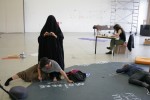
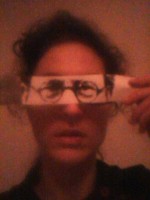




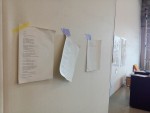




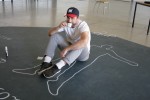








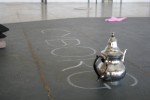


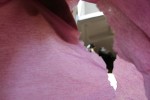





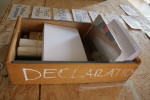
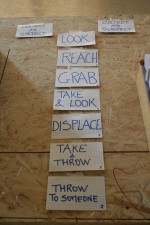





































































 i can't resist i need to touch
i can't resist i need to touch




























